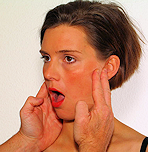Patient Info
-
Who is treating you?

The persons you will find in our list of therapists are all state registered and experienced physiotherapists, general practitioners or dentists who have taken part in a further education course with a minimum duration of 120 hours. The course includes the assessment, treatment and management of patients with headaches, neck pain or face pain (refer also to the section on courses). The treatment usually requires the cooperation of a physiotherapist with a specialized doctor.
If necessary, other professions such as dentists, orthopaedic surgeons, orthodontists, dentical/face surgeons, ENT or psychologists may be involved.
-
What does the therapist do?
 The treatments are not overly painful.
The treatments are not overly painful.Based on a thorough subjective examination (interview), your problem will be analysed in depth. The therapist will then form hypotheses about the potential reasons for the symptoms and evaluate the influence and relevance of the hypothesized sources by performing a physical examination.
Initially the physical examination will focus on the function of the jaws, the skull and the nerves in your face and skull. Additionally the therapist may decide to also examine the spine, the shoulder girdle and the hips.
-
What is the aim of the treatment?
 The aim is to find abnormal dysfunctions in the head, face or neck region that are relevant for your problem. If these are detected, the therapist will provide you with a treatment plan.
The aim is to find abnormal dysfunctions in the head, face or neck region that are relevant for your problem. If these are detected, the therapist will provide you with a treatment plan.After a maximum of 6 treatment session the progress will be reviewed and the therapist will decide together with you, whether the therapy should be continued. Depending on the progress so far the therapist will recommend to continue with therapy sessions or discharge you or refer you to a specialist.
-
What are the treatment components?
 The treatment consists of manual therapy techniques in the head, face and neck regions which are complimented by additional information, exercises and recommendations.
The treatment consists of manual therapy techniques in the head, face and neck regions which are complimented by additional information, exercises and recommendations.The additional management depends on the results of questionnaires and a pain diary that you will be asked to complete.
It also depends on your daily tasks and behavioural aspects. You may be asked to change certain activities or offered a pain management program.
-
What the therapist doesn't do
 The therapy will not be exessively painful.
The therapy will not be exessively painful.The therapist will not give you any medication or injections (this is part of the general practitioner's management).
The therapist will always involve the referring doctor if medication is required. The therapy will not only include manual therapy but will also focus on pain management strategies and home exercises.
-
What types of symptoms are likely to respond to this therapy?
 The therapist is initially interested in dysfunctions of the head and neck and their influence on your daily life activities.
The therapist is initially interested in dysfunctions of the head and neck and their influence on your daily life activities.He / she will focus on your dominant symptoms more than on the diagnostic title of the problem. Many patients with similar symptoms have various diagnostic titles.
Independent of this incongruence, we have collected a list of indications for this treatment concept, that may not be complete:
> Motoric retardation, developmental delay > Difficulties while breast feeding > Myofascial dysfunctions of the chewing system > Mouth and face pain > Myoarthropathies of the chewing system > TMJ problems > Occlusal disturbances > Cervicogenic headache > Atypical mouth pain > Cervical dystonia > Atypical facial pain > Craniosynosthosis > Atypical headache > Temporomandibular dysfunction > Atypical ear pain (otalgia) > Concentration disturbances > Inexplicable tooth ache > Concentration difficulties > Tinnitus (noise/ ringing in the ears) > Costen's syndrom > Difficulties with ear (eustachian) tubes > Intestinal colics > Opisthotonus > Problems with the disc in the TMJ > Orofacial dysfunctions > Dizziness and vertigo > Plagiocephalia > Facial paresis > Post-zoster pain > Birth trauma (difficulties during birth) > Whiplash associated disorder > Facial asymmetry > Torticollis > Zoster neuralgia > Head asymmetries > Excessive crying of a newborn > Tension Type Headache > Bracing > Grinding teeth/ Bruxism > Otitis media > Scull trauma, head injuries > Children with neck problems > Migraine > Trigeminal neuralgia > Ear and facial pain -
Final information
 At the end of the treatment the therapist will write a discharge letter to the referring doctor. He/she may suggest to continue some of the treatment components for a number of month with a low intensity to maintain the treatment results in the long term. This will be mentioned in the discharge letter.
At the end of the treatment the therapist will write a discharge letter to the referring doctor. He/she may suggest to continue some of the treatment components for a number of month with a low intensity to maintain the treatment results in the long term. This will be mentioned in the discharge letter.This will be mentioned in the discharge letter. It may be useful to arrange an appointment in a few month time to evaluate whether a relapse has occurred.
It is also a chance to ask potential further questions. If you should have questions now or would like to comment on this information, please contact one of the therapists from the therapist index on this website.
